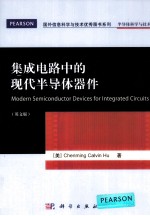图书介绍
集成电路中的现代半导体器件 影印版 英文版PDF|Epub|txt|kindle电子书版本下载

- (美)胡正明著 著
- 出版社: 北京:科学出版社
- ISBN:9787030326652
- 出版时间:2012
- 标注页数:354页
- 文件大小:63MB
- 文件页数:365页
- 主题词:半导体器件-英文
PDF下载
下载说明
集成电路中的现代半导体器件 影印版 英文版PDF格式电子书版下载
下载的文件为RAR压缩包。需要使用解压软件进行解压得到PDF格式图书。建议使用BT下载工具Free Download Manager进行下载,简称FDM(免费,没有广告,支持多平台)。本站资源全部打包为BT种子。所以需要使用专业的BT下载软件进行下载。如BitComet qBittorrent uTorrent等BT下载工具。迅雷目前由于本站不是热门资源。不推荐使用!后期资源热门了。安装了迅雷也可以迅雷进行下载!
(文件页数 要大于 标注页数,上中下等多册电子书除外)
注意:本站所有压缩包均有解压码: 点击下载压缩包解压工具
图书目录
1 Electrons and Holes in Semiconductors1
1.1 Silicon Crystal Structure1
1.2 Bond Model of Electrons and Holes4
1.3 Energy Band Model8
1.4 Semiconductors,Insulators,and Conductors11
1.5 Electrons and Holes12
1.6 Density of States15
1.7 Thermal Equilibrium and the Fermi Function16
1.8 Electron and Hole Concentrations19
1.9 General Theory ofnandp25
1.10 Carrier Concentrations at Extremely High and Low Temperatures28
1.11 Chapter Summary29
PROBLEMS30
REFERENCES33
GENERAL REFERENCES34
2 Motion and Recombination of Electrons and Holes35
2.1 Thermal Motion35
2.2 Drift38
2.3 Diffusion Current46
2.4 Relation Between the Energy Diagram and V,?47
2.5 Einstein Relationship Between D and μ48
2.6 Electron-Hole Recombination50
2.7 Thermal Generation52
2.8 Quasi-Equilibrium and Quasi-Fermi Levels52
2.9 Chapter Summary54
PROBLEMS56
REFERENCES58
GENERAL REFERENCES58
3 Device Fabrication Technology59
3.1 Introduction to Device Fabrication60
3.2 Oxidation of Silicon61
3.3 Lithography64
3.4 Pattern Transfer—Etching68
3.5 Doping70
3.6 Dopant Diffusion73
3.7 Thin-Film Deposition75
3.8 Interconnect—The Back-End Process80
3.9 Testing,Assembly,and Qualification82
3.10 Chapter Summary—A Device Fabrication Example83
PROBLEMS85
REFERENCES87
GENERAL REFERENCES88
4 PN and Metal-Semiconductor Junctions89
Part Ⅰ:PN Junction89
4.1 Building Blocks of the PN Junction Theory90
4.2 Depletion-Layer Model94
4.3 Reverse-Biased PN Junction97
4.4 Capacitance-Voltage Characteristics98
4.5 Junction Breakdown100
4.6 Carrier Injection Under Forward Bias—Quasi-Equilibrium Boundary Condition105
4.7 Current Continuity Equation107
4.8 Excess Carriers in Forward-Biased PN Junction109
4.9 PN Diode IV Characteristics112
4.10 Charge Storage115
4.11 Small-Signal Model of the Diode116
Part Ⅱ:Application to Optoelectronic Devices117
4.12 Solar Cells117
4.13 Light-Emitting Diodes and Solid-State Lighting124
4.14 Diode Lasers128
4.15 Photodiodes133
Part Ⅲ:Metal-Semiconductor Junction133
4.16 Schottky Barriers133
4.17 Thermionic Emission Theory137
4.18 Schottky Diodes138
4.19 Applications of Schottky Diodes140
4.20 Quantum Mechanical Tunneling141
4.21 Ohmic Contacts142
4.22 Chapter Summary145
PROBLEMS148
REFERENCES156
GENERAL REFERENCES156
5 MOS Capacitor157
5.1 Flat-Band Condition and Flat-Band Voltage158
5.2 Surface Accumulation160
5.3 Surface Depletion161
5.4 Threshold Condition and Threshold Voltage162
5.5 Strong Inversion Beyond Threshold164
5.6 MOS C-V Characteristics168
5.7 Oxide Charge—A Modification to Vfb and Vt172
5.8 Poly-Si Gate Depletion—Effective Increase in Tox174
5.9 Inversion and Accumulation Charge-Layer Thicknesses and Quantum Mechanical Effect176
5.10 CCD Imager and CMOS Imager179
5.11 Chapter Summary184
PROBLEMS186
REFERENCES193
GENERAL REFERENCES193
6 MOS Transistor195
6.1 Introduction to the MOSFET195
6.2 Complementary MOS(CMOS)Technology198
6.3 Surface Mobilities and High-Mobility FETs200
6.4 MOSFET Vt,Body Effect,and Steep Retrograde Doping207
6.5 QINVin MOSFET209
6.6 Basic MOSFETIV Model210
6.7 CMOS Inverter—A Circuit Example214
6.8 Velocity Saturation219
6.9 MOSFET IV Model with Velocity Saturation220
6.10 Parasitic Source-Drain Resistance225
6.11 Extraction of the Series Resistance and the Effective Channel Length226
6.12 Velocity Overshoot and Source Velocity Limit228
6.13 Output Conductance229
6.14 High-Frequency Performance230
6.15 MOSFET Noises232
6.16 SRAM,DRAM,Nonvolatile(Flash)Memory Devices238
6.17 Chapter Summary245
PROBLEMS247
REFERENCES256
GENERAL REFERENCES257
7 MOSFETs in ICs—Scaling,Leakage,and Other Topics259
7.1 Technology Scaling—For Cost,Speed,and Power Consumption259
7.2 Subthreshold Current—"Off"Is Not Totally"Off"263
7.3 Vt Roll-Off—Short-Channel MOSFETs Leak More266
7.4 Reducing Gate-Insulator Electrical Thickness and Tunneling Leakage270
7.5 How to Reduce Wdep272
7.6 Shallow Junction and Metal Source/Drain MOSFET274
7.7 Trade-Off Between/on and/off and Design for Manufacturing276
7.8 Ultra-Thin-Body SOI and Multigate MOSFETs277
7.9 Output Conductance282
7.10 Device and Process Simulation283
7.11 MOSFET Compact Model for Circuit Simulation284
7.12 Chapter Summary285
PROBLEMS286
REFERENCES288
GENERAL REFERENCES289
8 Bipolar Transistor291
8.1 Introduction to the BJT291
8.2 Collector Current293
8.3 Base Current297
8.4 Current Gain298
8.5 Base-Width Modulation by Collector Voltage302
8.6 Ebers-Moll Model304
8.7 Transit Time and Charge Storage306
8.8 Small-Signal Model310
8.9 Cutoff Frequency312
8.10 Charge Control Model314
8.11 Model for Large-Signal Circuit Simulation316
8.12 Chapter Summary318
PROBLEMS319
REFERENCES323
GENERAL REFERENCES323
Appendix Ⅰ Derivation of the Density of States325
Appendix Ⅱ Derivation of the Fermi-Dirac Distribution Function329
Appendix Ⅲ Self-Consistencies of Minority Carrier Assumptions333
Answers to Selected Problems337
Index341